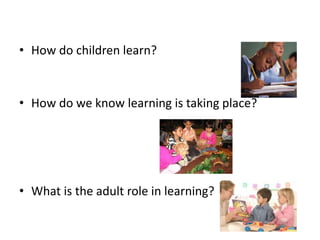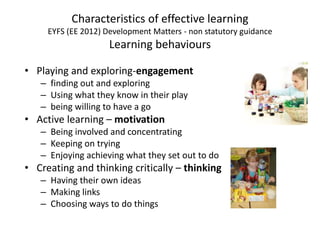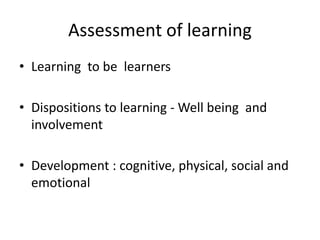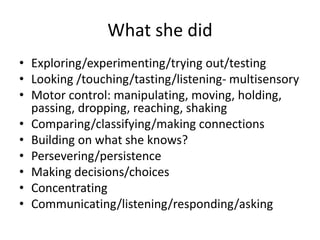Ev681 2 whole cohort session 15.9.2015
- 1. First thoughts on Learning and Teaching EV681: Pedagogy, Principles and Practice in Early Education EV682: Contemporary issues in Teaching and Learning
- 2. • How do children learn? • How do we know learning is taking place? • What is the adult role in learning?
- 3. When does learning begin?
- 4. What helps you learn?
- 5. Characteristics of effective learning EYFS (EE 2012) Development Matters - non statutory guidance Learning behaviours • Playing and exploring-engagement – finding out and exploring – Using what they know in their play – being willing to have a go • Active learning – motivation – Being involved and concentrating – Keeping on trying – Enjoying achieving what they set out to do • Creating and thinking critically – thinking – Having their own ideas – Making links – Choosing ways to do things
- 6. Assessment of learning • Learning to be learners • Dispositions to learning - Well being and involvement • Development : cognitive, physical, social and emotional
- 7. Hello Jamie Watch the clip, Note down - What learning is taking place? - any characteristics of effective learning ? - How was this learning facilitated?
- 8. What she did • Exploring/experimenting/trying out/testing • Looking /touching/tasting/listening- multisensory • Motor control: manipulating, moving, holding, passing, dropping, reaching, shaking • Comparing/classifying/making connections • Building on what she knows? • Persevering/persistence • Making decisions/choices • Concentrating • Communicating/listening/responding/asking
- 9. Goswami 2015 Current research from Neuroscience has highlighted that learning takes place in four ways; 1. Statistical learning- visual, auditory (Piaget calls sensory learning) Prototype/schema 2. Analogy – comparisons with other types for similarities and differences (Piaget: accommodation and assimilation- schema development) 3. Imitation – watching and repeating what others do (social learning theory) 4. Causal – problem solving
- 10. Connectionist • All four are important for learning - how they interact with each other varies from person to person (genetics, experience) • Learning is unique to each individual
- 11. Child brain Adult brain
- 12. How was Jamie’s learning and development facilitated? • Time • Space • Resources • Knowledge of Jamie and stage of development • Planning for what comes next • Responsive, • Positive interactions
- 13. Piaget and Vygotsky • The environment and the relationships within them are key to children’s learning and development
- 14. How are you going to grow learning in the children you will teach?
- 15. Goswami (2015) p24-25 • 1. Learning is socially mediated • 2. Learning relies on multi-sensory networks across the brain (not VAK) • 3. knowledge gained through active experience • 4. children think in the same way as adults • 5. Language is crucial for learning • 6. Imaginative/role play supports thinking, reasoning and understanding • 7. all children learn differently – no one size fits all
- 16. First thoughts on Pedagogy • What did you notice? • What are the children learning? • What similarities and differences do you see between the sequences? • What are the teachers’ roles here? Is this teaching?
- 17. EV681- before next session 1. Set up your word press blog 2. Read ‘Pedagogy the silent partner’ 3. Blog post 1* responses to first lecture on teaching and learning 4. Watch video on supporting positive behaviours in early years
- 18. To conclude EV682 Follow up from today: • Set up your wordpress blogs • Blog post 1* and responses to First thoughts on teaching and learning
- 19. • Goswami, U. (2015) Children’s cognitive development and learning , report for the Cambridge Primary Review Trust
Editor's Notes
- The module will help you to answer this
- Remind students of follow task and blog post.


















